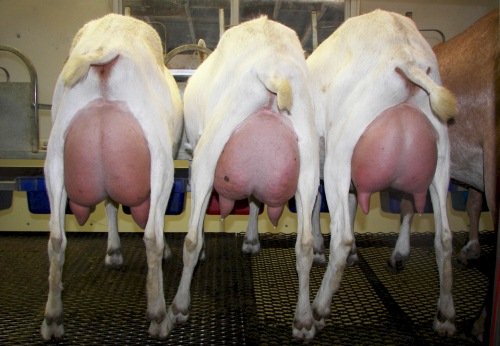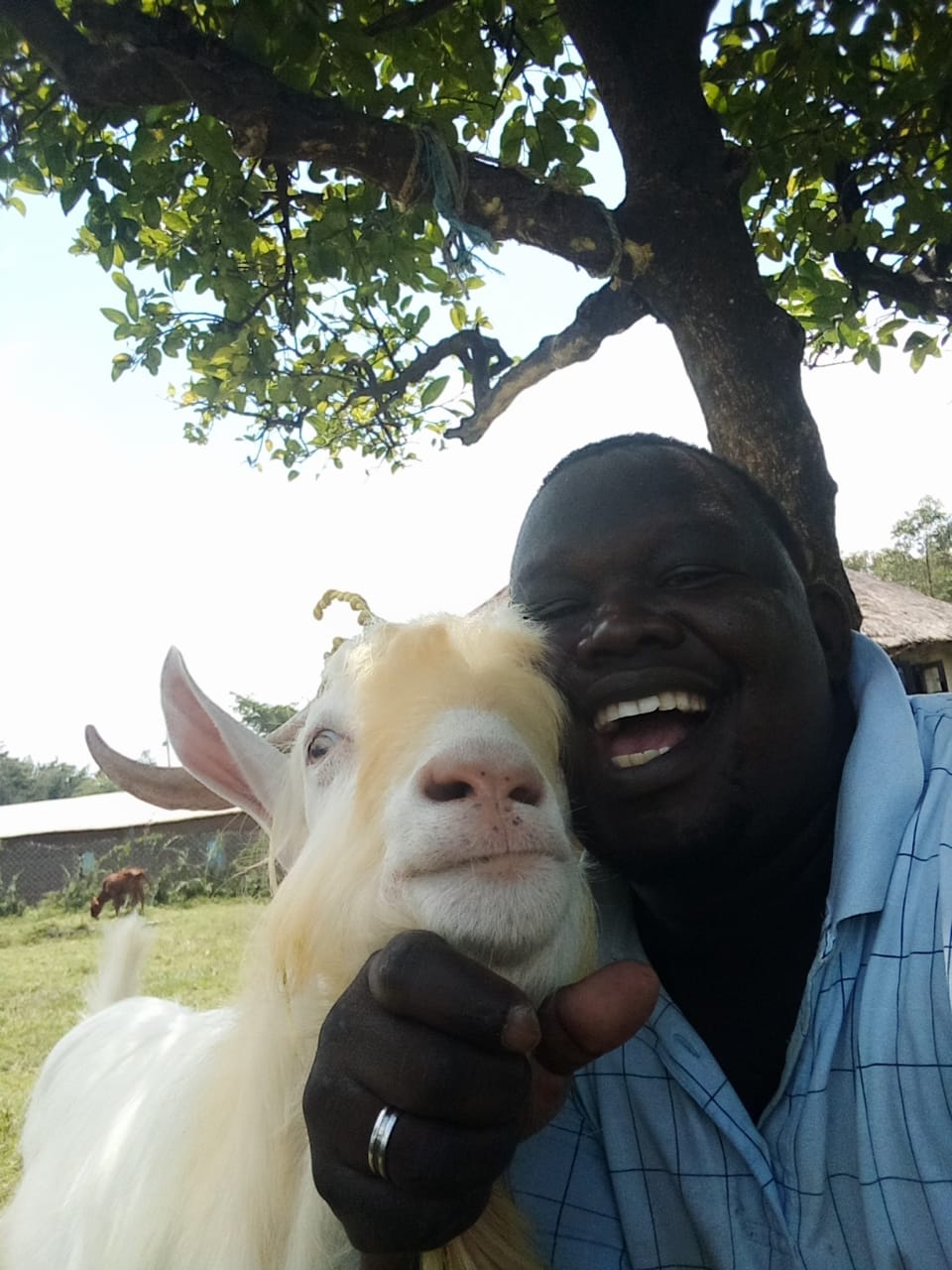
Saanen dairy goats. Photo courtesy.
Dairy goats farming in Kenya has doubled in recent years following an increased interest in the venture by most farmers in the country. This is because consumers have come to prefer the goats’ milk to that of other livestock due to its nutritious and easy to digest qualities.
According to statistics from the Ministry of agriculture, as at the end of 2018, the total population of goats in the country was 15 million out of which 400,000 were dairy goats. This was an increase from 13 million of which about 200,000 were dairy goats in 2016.
In addition, dairy goat farming is emerging as a high-return option for Kenyan small-scale farmers. Although faced in some regions by marketing and distribution challenges, the sector soars in some regions of the country especially the high potential areas of the Kenyan highlands, according to a 2015 case study of Small-scale Dairy Goat Farmers in Laikipia, Kenya by Juliah Wanjiru Kinyua for the University of Nairobi.
Despite these, many farmers still do not know how to maximise profit from the dairy animals something which starts from choosing of the right dairy goat breed for high-milk production.
In Kenya, the common dairy goat breeds reared include Saanen, Toggenburg and Alpines, and their crosses but according to National Farmers Information Service (NAFIS), Saanen breed is the milk queen in the goat world.
RELATED CONTENT: Rearing five dairy goats is 45 per cent more profitable than a dairy cow
Saanen characteristics
The breed whose origin is Switzerland is all white or creamy coloured with pink skin pigmentation with its face straight, ears are upright and alert (pricked), short hair and fine and a long body.
As a rule, Saanen does not carry tassels. Under good management, it produces 3-5 litres of milk per day depending on management. They are prolific and have a high twinning rate.
“I milk four litres every day from one of my Saanen breeds and sometimes it get up to four and a half if well-fed,” said Patrick Odhiambo, a farmer from Manyatta A in Kisumu County.
He had left his work as an artisan with a company in Kisumu City to concentrate in farming in 2012 having learnt that with the dairy goats, he would be pocketing about Sh100 per day from just a single goat.
RELATED CONTENT: Former driver becomes award winning dairy goat farmer
Just like other goats, the breed is very easy to keep because they require small land, little capital, have higher prolificacy (number of litter born per kidding) and are generally hardy.
For Patrick, Sh30,000 was enough for him to start the venture. With this amount, he was able to buy one male goat at Sh15,000 and the remaining Sh15,000 to build a shed and feeding.
When well taken care of for nine months which is the mature period, a male Saanen goat weighs 70-100kg and mature female weighs 50-70 kg. The female measures 74 -80 cm in height while the mature buck measures 81-92cm.
The female goat’s udder is usually shapely and well attached and it can produce up to four litres of milk if well fed.
RELATED CONTENT: Search for nutritious milk lands farmer into lucrative dairy goat rearing
Feeding
Just like any other goats, Saanen should also be fed on balanced diets in energy, protein, minerals, vitamins and clean water when housed. These can be found from a variety of grasses, shrubs and plants.
“Carbohydrate sources comprise Napier grass, Rhodes grass, Kikuyu grass, molasses and cereals like maize while proteins from fodder trees and legumes such as lucerne, calliandra, leucena, desmodium, mulberry, sweet potato vines, dairy meal, cottonseed cake, sunflower cake, soybean cake and other oil seed cakes,” Hezron Kiprono, a sheep and goats breeder from Baringo County.
However, farmers should note that feeds needed by dairy goats vary depending on their weight and stage of development. A goat should feed 3.5 per cent of its bodyweight of dry matter.
RELATED CONTENT: Five dairy goats have more returns than a dairy cow
Sources of good dairy goat breeds and Artificial Insemination (AI)
For farmers who wish to get best goat breeds, Dairy Goats Association of Kenya for the Alpine breed, Meru Goat Breeders Association for Toggenburgs and Nyanza Goat Farmers Association for the Saanens comes in handy.
Goats can be bred through natural breeding or Artificial Insemination (AI). AI though is not so popular but the services can be accessed from reputed institutions like Egerton University.
For natural breeding, the recommended young buck to doe ratio is 1:25. Under suitable management, goats come on heat at eight months, sometimes earlier. However, it is recommended to mate the does as from 12 months.
The animals experience a heat period lasting between 24 – 26 hours and have a gestation period of 150 days.
Patrick sells three to seven months old male and female goats at Sh15,000 while over seven months old and served doe he sells at Sh25,000.
Exporter looking for Cavendish banana out growers to meet increasing export market demand
Lagran group limited, a Nairobi-based fresh produce exporter is seeking to increase the number of their out growers form the current 100 to grow Cavendish banana variety, one of the company’s specialty crop to meet the increasing demand in the export markets.
According to Linda Lagran, the company’s marketing officer, the company exports 50 tonnes of the bananas every month to the Middle East, Asia and European countries. However, they have never met the demand which she describes as huge hence the need for more out growers.
“We started outsourcing farmers to grow this variety of bananas four years ago but we have never satisfied the markets whose demands keep on increasing every other time,” said Linda.
South Korea, for instance, which in December last year gave Kenya a clean bill of health to export green bananas and broccoli to the country, imports 70 per cent of its food and in 2017, bananas were the most imported product in the country recording 834,000 tonnes, worth $1.24 billion, according to statistics released in September the same year by the South Korea Customs Service.
This has intensifies the campaign for the production of the crop by fresh produce export players in Kenya in a bid to curb the trade deficit.
In this, Lagran has been working with farmers within East Africa (Kenya and Tanzania) to grow the crop for Lagran Horticulture Crops for export on a contract basis which is overseen by Agriculture and Food Authority (AFA) which is a promoter and regulator of contract farming between farmers and buyers in Kenya.
How to work with Lagran
Farmers who are keen to enter into the deal with Lagran Horticulture Crops are supposed to ensure that they have a land for production which should not be less than an acre and a constant water source that can sustain the crop.
“Bananas is a Moisture-loving plant hence it needs regular watering to sustain its large tropical leaves and produce sweet tasty fruits. This is why we must ensure that our growers have a constant water supply for constant production process,” said Linda.
They are then required to reach out to the company which through its team of agronomists ensure that the key first requirements are met including soil testing and the farmers are set to start organic production of the crop, a practice the company promotes since the use of synthetic fertilisers and chemicals has proven to be a turn off to most consumers.
From there, the growers must buy certified seedlings from the company for quality purposes.
“We understand that to reap big from the venture, a farmer should have good quantities of unpolluted and superior planting material and promote smart farm hygiene practices through correct management of the crop. This is why we insist that they buy the seedlings which we are sure of their qualities,” said Linda.
The farmers are then offered the following:
-Agronomical support
-Technical support
-Marketing of the Produce
-Irrigation systems setup
-Produce value addition among others
Possible returns
An acre can host 500 banana plants that if well tendered, they produce 1,000 bunches a year, each weighing between 80kg to 120kg after 340 days maturity period.
Lagran buys the bunches whose fruits measure 39 to 49mm for thickness and a length of 20 to 23cm each at Sh18-20 a kilo for export while the ones which do not meet the requirements are sold locally.
They also buy chilli, passion, pawpaw, tree tomato, avocado and mango fruits from farmers and just like bananas, only grade 1 and 2 are exported while the rest are sold in local markets.
The company can be reached on +254728201058 or email This email address is being protected from spambots. You need JavaScript enabled to view it.

Patrick Odhiambo, a Saanen goat farmer in Kisumu posing with a mature buck. Photo courtesy.
















Comments powered by CComment